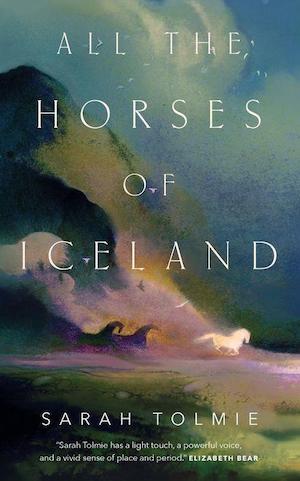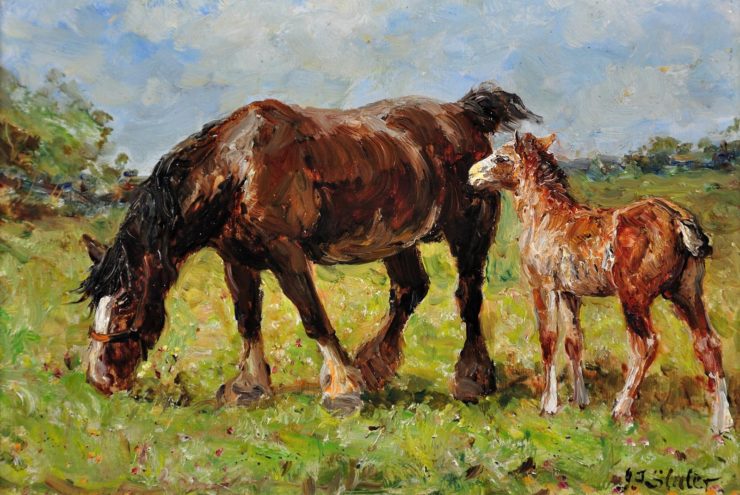Any discussion of breeding, such as the one I posted last time, always comes back not just to how but why. I talked about that on the individual level—are the mare and stallion a good match for each other according to the standards of their breed and type, and the goals of the particular breeding program? Does the offspring have a good probability of equaling or exceeding the quality of its parents? Are the parents themselves of sufficient quality to be bred on?
There are other, larger considerations as well. As it happened, because Synchronicity is one of my patron deities, around the time my article on breeding went live, one of my follows on Facebook, who happens to be an officer of my horses’ breed organization, shared a most informative screenshot from an organization called the Equus Survival Trust. This organization, founded in 2004, records and studies equine populations around the world, focusing on breeds and strains that are particularly low in numbers. It tracks those numbers from year to year, and supports individuals and organizations who are working to preserve and protect those breeds and strains.
I had known that rare breeds were being tracked, but I didn’t know the name of the organization, or how it did what it does. Its purpose is to preserve and protect rare or unique varieties of horses and donkeys, for their own sake and for the sake of greater diversity in the equine world.
So many of them are history on the hoof, remnants of populations that were bred or established in particular regions or for particular purposes. Some hark back to an original type or bloodline. The Lippitt Morgan, for example, is a tiny fraction of a large and thriving breed, but the type and bloodlines it represents are perhaps the closest to the original stock, to Justin Morgan’s famous stallion and his immediate descendants. It’s worth preserving for its own sake, but also as a rootstock to return to when the breed in general diverges more and more widely from the type and traits that made it the Morgan horse to begin with.
Such divergence is a common problem in breeding. Fads and fashions change. So do the uses of the animals. The old working types of draft horse are fading away in favor of lighter, flashier versions, such as the Clydesdales we love to see in the Budweiser hitches.
Old-fashioned draft horses were solid, sturdy, and functional, but they were not about the flash. They didn’t need to be. They existed to get the job done.
That job now is done by machinery. There are farms that use draft horses, but in the industrialized world, that’s much more of a choice than a necessity. Breeders of these horses cater to a vanishingly small market.
Horse breeding is expensive. The old joke goes, “How do you make a small fortune breeding horses? Start with a large one.” Of course there are breeders who make big money, notably in the racing world and to a lesser extent in the world of the big-time show breeds—Quarter Horses, Arabians, the saddle-seat breeds including the Morgan—but for most, it’s a labor of love. Get down into the really small breeds and it’s just about all love and precious little money.
Buy the Book


All the Horses of Iceland
Horse breeding at any level is a passion. It’s an obsession and a lifework. Preservation breeding takes that a step further. It focuses on a small population and a particular standard, a set of traits that distinguishes that breed from any other. These traits, to the preservationist breeder, are worth breeding on, working keeping in the gene pool both for what they are in themselves and for what they can contribute to the species as a whole.
To put it simply, the breeder just plain loves what that breed is and does, how it looks and moves, and what it represents in the broader historical context. If you look at a Lippitt Morgan of the old strain, you’re looking at a pretty close approximation of what Justin Morgan’s horse was putting on the ground in the 1700s. A Dales pony or an English Shire horse or a Mammoth Jack donkey carries in itself a whole weight of history, a line that goes back to historical stock bred and developed either by nature itself or by humans breeding for a particular purpose.
It’s time travel on the hoof. It carries that part of the species forward into whatever future the planet has, and preserves a little bit of biodiversity in the face of our escalating extinction event. Best of all, it’s alive and breathing and being itself, part of a species that has been inextricably entwined with ours for millennia.
There’s nothing easy about it. It’s hard work to keep track of the breed, study its history, understand why its rules and standards exist; to encourage breeders but also to hold them to the standard. Quantity matters to a breed in danger of extinction, but quality is just as important. It’s a difficult balancing act, repeated over and over across numerous breeds and types.
Sometimes even the best efforts fail. The breed or type or strain goes extinct. There’s not enough support for the domesticated breed or type, or in the case of feral strains, the habitat is lost or the animals succumb to disease or disaster.
Sometimes—and this is why the Equus Survival Trust exists—the effort succeeds. The breed or strain builds up its numbers, manages its standards, and takes itself off the Critical list. That’s what happened to my own breed, the Lipizzan. In the 2022 listing, among the Vulnerable and Threatened and Critical and sadly Extinct, it’s the one in green. It’s Recovering.
We’re celebrating. So many people in so many countries have worked so hard to raise the numbers without losing the traits that make a Lipizzan a Lipizzan—against the pressures every breeder faces, to satisfy current fads and fashions, rather than to preserve the historical type.
It’s a triumph, but it doesn’t mean the work has stopped or even slowed. A breed, like the equines that comprise it, is a living thing. Keeping up the numbers, keeping up the quality, keeping up the interest of both breeders and enthusiasts, takes constant effort and tireless monitoring. All for love, and to keep a little beauty in the world—whether your ideal is a very shaggy French donkey or an elegant performer in the halls of kings.
Judith Tarr is a lifelong horse person. She supports her habit by writing works of fantasy and science fiction as well as historical novels, many of which have been published as ebooks. She’s written a primer for writers who want to write about horses: Writing Horses: The Fine Art of Getting It Right. She lives near Tucson, Arizona with a herd of Lipizzans, a clowder of cats, and a blue-eyed dog.










